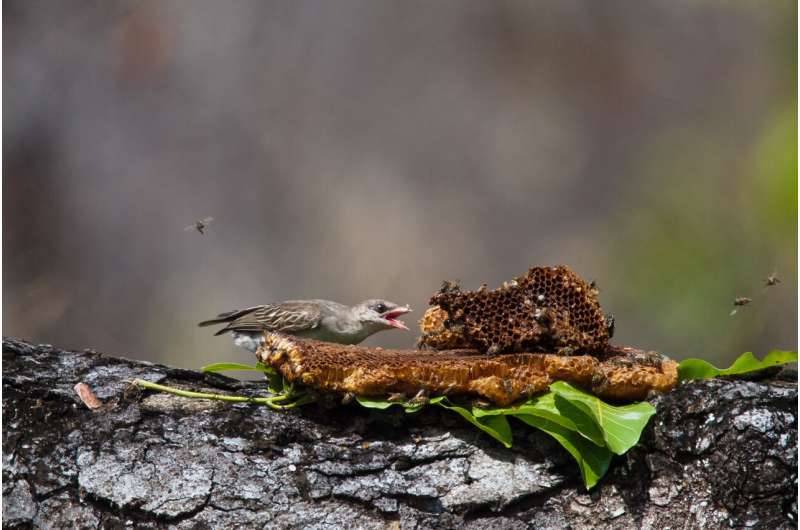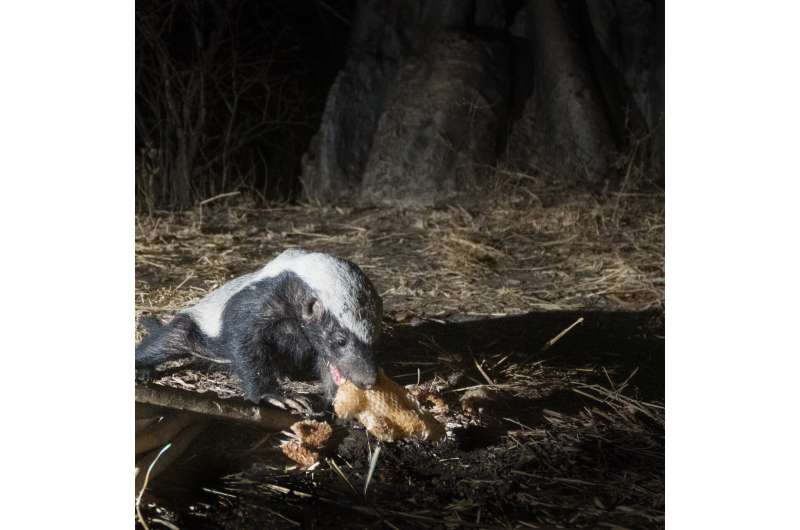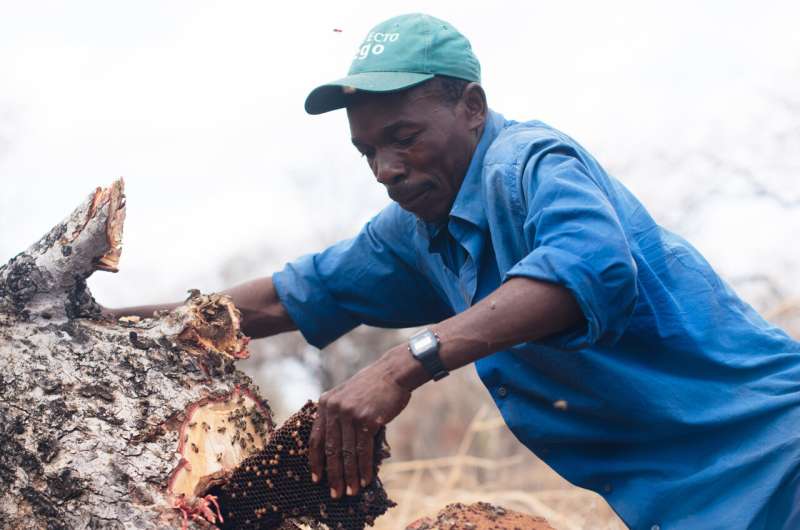This article has been reviewed according to Science X's editorial process and policies. Editors have highlighted the following attributes while ensuring the content's credibility:
fact-checked
peer-reviewed publication
trusted source
proofread
Birds and honey badgers could be cooperating to steal from bees in parts of Africa

The honeyguide bird loves beeswax, but needs help breaking open bees' nests to get it. So it shows a honey badger the way to the nest, who rips it open and together they share the rewards. Or so the story goes.
This Disneyesque tale of two species cooperating for mutual benefit has captivated naturalists for centuries—but is it true?
"While researching honeyguides, we have been guided to bees' nests by honeyguide birds thousands of times, but none of us have ever seen a bird and a badger interact to find honey," said Dr. Jessica van der Wal at the University of Cape Town, lead author of the study.
She added, "It's well-established that honeyguides lead humans to bees' nests, but evidence for bird and badger cooperation in the literature is patchy—it tends to be old, second-hand accounts of someone saying what their friend saw. So we decided to ask the experts directly."
In the first large-scale search for evidence of the interaction, a team of young researchers from nine African countries, led by researchers at the University of Cambridge and the University of Cape Town, conducted nearly 400 interviews with honey-hunters across Africa.
People in the 11 communities surveyed have searched for wild honey for generations—including with the help of honeyguide birds.
Most communities surveyed were doubtful that honeyguide birds and honey badgers help each other access honey, and the majority (80%) had never seen the two species interact.
But the responses of three communities in Tanzania stood out, where many people said they'd seen honeyguide birds and honey badgers cooperating to get honey and beeswax from bees' nests. Sightings were most common among the Hadzabe honey-hunters, of which 61% said they had seen the interaction.
"Hadzabe hunter-gatherers quietly move through the landscape while hunting animals with bows and arrows, so are poised to observe badgers and honeyguides interacting without disturbing them. Over half of the hunters reported witnessing these interactions, on a few rare occasions," said Dr. Brian Wood from the University of California, Los Angeles, who co-authored the study. The report is published in the Journal of Zoology.

Examining the evidence
The researchers reconstructed step-by-step, what must happen for honeyguide birds and honey badgers to cooperate in this way. Some steps, such as the bird seeing and approaching the badger, are highly plausible. Others, such as the honeyguide chattering to the badger, and the badger following it to a bees' nest, remain unclear.
Badgers have poor hearing and bad eyesight, which isn't ideal for following a chattering honeyguide bird.
The researchers say perhaps only some Tanzanian populations of honey badgers have developed the skills and knowledge needed to cooperate with honeyguide birds, and they pass these skills down from one generation to the next.
It's also possible, they say, that badgers and birds do cooperate in more places in Africa but simply haven't been seen.
"The interaction is difficult to observe because of the confounding effect of human presence: observers can't know for sure who the honeyguide bird is talking to—them or the badger," said Dr. Dominic Cram in the University of Cambridge's Department of Zoology, a senior author of the study.

He added, "But we have to take these interviews at face value. Three communities report to have seen honeyguide birds and honey badgers interacting, and it's probably no coincidence that they're all in Tanzania."
The authors highlight the need for more scientists to engage with relevant communities and learn from their views and observations, and integrate scientific and cultural knowledge to enrich and accelerate research.
Partner switch?
The greater honeyguide bird, Indicator indicator, is well-known to communities across many African countries, where it has been used for generations to find bees' nests. Wild honey is a high-energy food that can provide up to 20% of calorie intake—and the wax that hunters share or discard is a valuable food for the honeyguide.
Humans have learned how to read the calls and behavior of the honeyguides to find wild bees' nests.
"The honeyguides call to the humans, and the humans call back—it's a kind of conversation as they move through the landscape towards the bees' nests," said Dr. Claire Spottiswoode from the University of Cambridge's Department of Zoology, joint senior author of the study.
With our control of fire and tools, humans are useful partners to honeyguides. We can cut down trees, and smoke the bees to subdue them before opening their nests. Honey badgers, Mellivora capensis, are more likely to make the bees angry—and aggressive bees sometimes sting the birds to death.
But honeyguide birds have been around far longer than modern humans, with our mastery of fire and tools.
"Some have speculated that the guiding behavior of honeyguides might have evolved through interactions with honey badgers, but then the birds switched to working with humans when we came on the scene because of our superior skills in subduing bees and accessing bees' nests. It's an intriguing idea, but hard to test," said Spottiswoode.
More information: J. E. M. van der Wal et al, Do honey badgers and greater honeyguide birds cooperate to access bees' nests? Ecological evidence and honey‐hunter accounts, Journal of Zoology (2023). DOI: 10.1111/jzo.13093
Journal information: Journal of Zoology
Provided by University of Cambridge



















